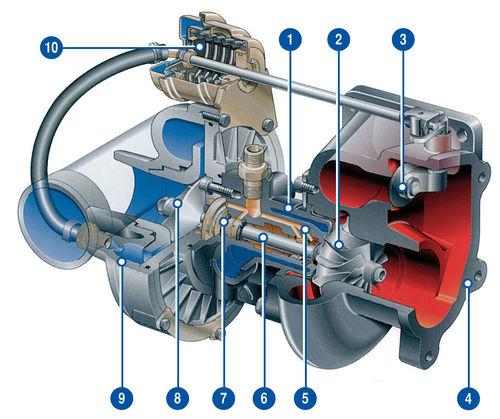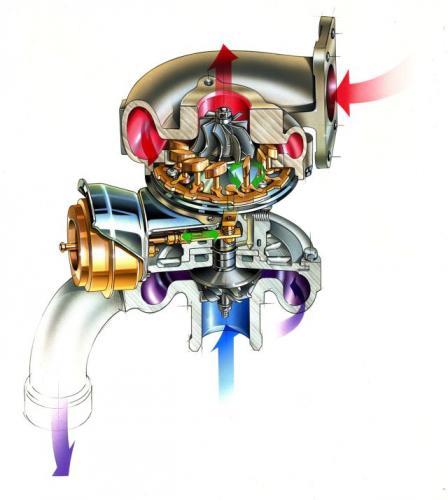
Operation of turbochargers
 Turbochargers are commonly used to improve the performance of gasoline and diesel engines. Their durability depends on proper use.
Turbochargers are commonly used to improve the performance of gasoline and diesel engines. Their durability depends on proper use.
Turbochargers are commonly used to increase the performance of gasoline and diesel engines. The principle of their operation is to connect the exhaust gas turbine with a rotor that compresses the air injected into the cylinders.
The turbocharger has a number of advantages, including: a simple design, the absence of an additional drive and a relatively low manufacturing cost. The device also has drawbacks such as a delay between the driver pressing the gas and the response of the turbine, commonly referred to as "turbo lag", and being susceptible to misoperation. Turbo hole caused  the inability of the compressor to independently adapt to changes in engine speed and load. Solutions already exist to improve the adaptability of turbochargers. These are bypass valves that direct excess exhaust gases to the exhaust side, and more technically advanced turbochargers with variable turbine geometry.
the inability of the compressor to independently adapt to changes in engine speed and load. Solutions already exist to improve the adaptability of turbochargers. These are bypass valves that direct excess exhaust gases to the exhaust side, and more technically advanced turbochargers with variable turbine geometry.
In operating practice, the most important thing for a car user is knowledge of the conditions that have a significant impact on the duration of trouble-free operation of a turbocharger. First, the turbocharger rotor has a certain mass and dimensions, as well as an associated mass moment of inertia. During operation, the rotor accelerates to a speed of 100 - 120 thousand rpm. This is 10 times faster than a Formula 1 car engine. Therefore, the turbine rotor is precisely balanced and its bearing lubricates the oil supplied by the engine's feed pump. When operating a turbocharger, in addition to maintenance, driving technique is of great importance.
To prevent the ingress of dirt, the intake air must be kept clean by changing the filter regularly. Any change in balance, such as dirt deposits, at these high speeds contributes to premature bearing wear. Particular attention should be paid to the cooling and lubricating medium, observing the engine oil change intervals. Also, do not use an oil of a lower quality class than recommended by the car manufacturer. Experiments with changing the type of oil, viscosity class and quality adversely affect the engine and its units. An increase in the degree of oil contamination, the loss of its lubricating and protective properties adversely affects the durability of bearings and the condition of the entire engine. In units with high mileage, “taking” oil, its level should be checked regularly and topped up.
After starting the internal combustion engine for some time (shorter in summer, longer in winter), oil does not flow to various mechanisms, including compressor bearings. During this period, they are lubricated with a thin sticky layer, due to the viscosity of the lubricant. Therefore, after starting a cold engine, sharp acceleration of the gas and abrupt starts should be avoided. This way of driving causes the bearings to be insufficiently lubricated for some time, which reduces their life. On the other hand, while driving after warming up the power unit, it is advisable to keep the engine running in the range of medium and high speeds. Proper engine shutdown is very important to compressor longevity. After the end of the drive, the oil pump stops working. It does not supply a portion of fresh oil to the bearings of the turbine, the accelerated rotor of which continues to rotate at a tremendous speed for several seconds. During this time, the oil lubricating the bearings becomes very hot, charring occurs in it, particles are formed that scratch the precisely made bearing races, which leads to their destruction. When running a turbocharged engine, wait a few seconds before shutting it off. At this time, the speed of the turbine slows down and the chance of damage to the bearings is reduced.
The period of trouble-free operation of a turbocharger largely depends on the mode of its operation. However, it should be emphasized that there were a series of devices that were poorly developed by manufacturers and failed after a relatively short run. A typical sign of turbocharger damage is clearly felt vibrations at the place of its installation. In case of severe damage, metal-on-metal friction is heard, a large amount of white smoke comes out of the exhaust pipe, the car still does not accelerate.
Damaged turbochargers can be regenerated. Specialist workshops have the appropriate knowledge, experience and repair kits. The cost of a typical regeneration is / depending on the size of the turbine / from PLN 800 to 2000 and several times lower than the price of a new device.

